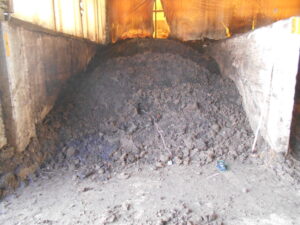Pig Farm Achieves 94% Ammonia Removal with 2,500 ppm and Quadruples Deodorization Capacity (Client: Hokkaido Pig Farm)
This case study introduces a pig farm in Hokkaido where the switch from wood chip deodorization to porous glass deodorization effectively removed odors that could not be eliminated with the previous method.
- Products Introduced
- MIRAIE Biological Deodorizing Equipment
- Client and Location
- Hokkaido / Pig Farm
- Processed Material
- Livestock Manure (17,000 pigs)
- Issue
- Removing high concentration ammonia (2,500-2,800 ppm) from compost
Overview of Composting
At this farm, pig manure is composted using a vertical fermentation unit, with odors from the fermentation unit treated by a biological deodorization tank with wood chips. However, the ammonia concentration in the odors from the fermentation unit was over 2,500 ppm, and the removal rate with wood chips was around 18%, which was insufficient. Consequently, ammonia concentrations close to 2,000 ppm were being released into the atmosphere.
Replacing Wood Chips with “MIRAIE Biological Deodorizing Equipment”
 ➡
➡ 
To improve deodorization efficiency, the wood chips in the deodorization tank were replaced with MIRAIE Biological Deodorizing Equipment (porous glass deodorization). The removal capacity was set to achieve approximately 95% removal.
The existing tank was retained, and the structure of the piping at the bottom of the tank was modified to ensure even odor removal.
After Installation
After installation, the distribution of air flow was improved, allowing for effective removal across the entire tank.
The ammonia concentration in the intake was reduced from 2,400 ppm to approximately 0-80 ppm after deodorization.
Additionally, the removal rate improved significantly from about 18% before installation to over 98% afterward.
Deodorization Improvement by Over Four Times

The switch to porous glass deodorization almost completely removed the odors. Compared to wood chips, porous glass deodorization demonstrated over four times greater effectiveness.
Summary
Vertical fermentation systems are widely used in pig and poultry farms but produce extremely high concentrations of exhaust gases, around 2,000-3,000 ppm NH3.
Many facilities are equipped with biological deodorization tanks using woody materials such as bark and sawdust, but there are several issues:
- Shortly after operation begins, the removal rate significantly decreases.
- The woody material becomes depleted (volume decreases and becomes compacted), increasing airflow resistance and preventing proper exhaust of gases.
- The inability to exhaust gases affects the moisture evaporation capacity of the composting equipment, leading to inefficient composting.
- Replacing the woody material restores performance, but it involves costs and labor, including purchasing new woody material, replacement costs (heavy machinery and labor costs), and disposal of the removed woody material.
Porous glass deodorizers use foamed glass as a carrier, so there is no risk of microbial degradation or volume loss as with wood.
This has advantages such as:
- It provides stable performance over a long period.
- It eliminates the cost and labor associated with replacing the carrier material.
- It achieves significant removal effects with a small amount of carrier material.
Introduction of the Product

MIRAIE Biological Deodorizing Equipment
Four Times the Removal Capacity of Conventional Biological Deodorizers
Odor problems plague many compost producers. The porous glass device solves the problems of conventional deodorization technologies in terms of performance, cost, and installation area.
writer
CORPORATIONMIRAIE
We are a plant manufacturer specializing in composting and recycling equipment. We provide comprehensive support to customers facing composting and odor issues and strive to strengthen production systems to improve productivity.







 Facebook
Facebook X
X Hatena
Hatena Poket
Poket




